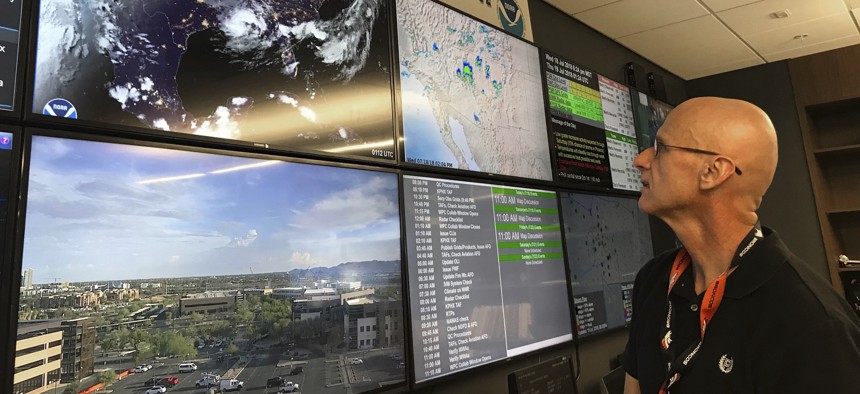
n this Wednesday, July 18, 2018 photo, National Weather Service forecaster Marvin Percha reviews monitors that track satellite and Doppler radar images, as well as his colleagues' forecasts posted on social media, at Tempe, AZ. AP Photo/Anita Snow
US Government To Restrict Sale of AI for Satellite Image Analysis
Software that can analyze satellite photos would be treated like a weapon.
The use of machine learning and AI to analyze satellite images could revolutionize the way governments, militaries, investors, and researchers track changes in the world around them. But if you’re a U.S. maker of such software, it’s about to become harder to export your products.
The federal rule change, published on Monday, affects software “‘specially designed’” to train deep learning neural networks “on the analysis of geospatial imagery.” The software would be classified as a dual-use technology under the Wassenaar Arrangement, subject to many of the same restrictions for exporting arms.
The rule affects software that would “provide a graphical user interface that enables the user to identify objects (e.g., vehicles, houses, etc.) from within geospatial imagery” and that “Trains a Deep Convolutional Neural Network to detect the object of interest from the positive and negative samples; and identifies objects in geospatial imagery using the trained Deep Convolutional Neural Network.”
Applying machine learning to the identification of objects in satellite imagery is a big U.S. military concern. Military leaders frequently talk about the wide disconnect between the amount of video and satellite footage that the United States collects and scarcity of analysts to look through the footage and see what’s relevant to operations. They’ve invested heavily in software tools that can monitor or scan that footage, including satellite footage, and then tip a human analyst to pay attention to something of relevance. Perhaps the best example is Project Maven, a military AI project to identify objects of interest or detect changes in scenery to help analysts and operators cut through lots of imagery and footage very quickly.
But the U.S. military isn’t the only group or entity with a legitimate interest in overhead satellite imagery, and possibly automating the detection of objects of interest in that imagery. For instance, hedge funds and other financial analysts use satellite images to predict retail trends, such as parking lot density around the holidays. Healthcare researchers and epidemiologists can use satellite footage to monitor healthcare trends also by monitoring parking lot density at hospitals and clinics. Nonprofit civic research groups have used satellite images to draw global attention toward events and happenings like resource pillaging and ethnic cleansing.
The rule change would have big effects for the future of software makers that are looking to produce AI tools for the analysis of satellite photos. But it could also, potentially, have a chilling effect on the ability of civilian groups to monitor changes and events of public interest.
NEXT STORY: What's Next for Iran's Cyber Actors?




